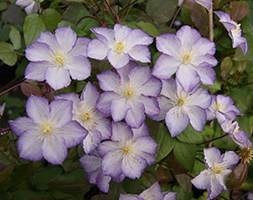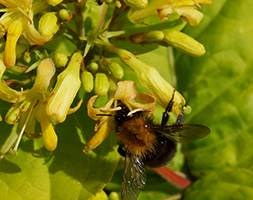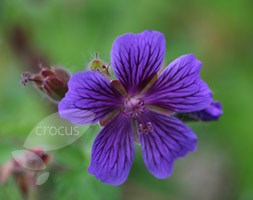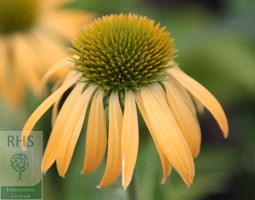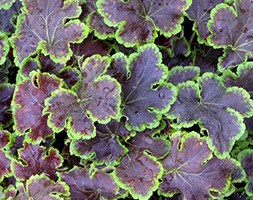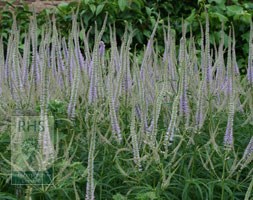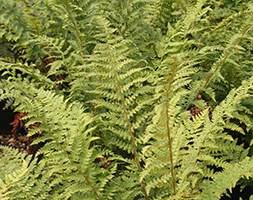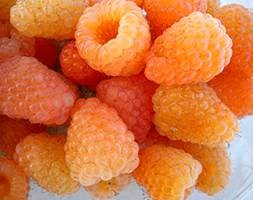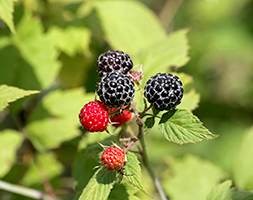New products at Crocus
by Sarah - September 13th, 2015.Filed under: Crocus, New Products.
Crocus just added these new products
Clematis Lucky Charm (‘Zo09067’) (PBR) (clematis (group 3)) £17.99
Position: full sun or partial shade Soil: fertile, well-drained, neutral soil Rate of growth: fast-growing Flowering period: June to September Hardiness: fully hardy There are a couple of great features of this new clematis. These include a never before seen colouring on a single-flowered clematis – and the way the relatively large flowers are held on the stem (facing either upwards or outwards). Its free-flowering too, so when grown in a sunny spot, it will produce an abundance of flowers all the way through summer, and even into autumn. Garden care: In early spring cut back the previous year’s stems to a pair of strong buds about 15-20cm (6-8in) above ground-level and apply a slow-release balanced fertiliser and a mulch of well-rotted garden compost around the plant, avoiding the immediate crown.
Diervilla rivularis Honeybee (‘Diwibru01’) (PBR) (bush honeysuckle) £9.99
Position: full sun or partial shade Soil: fertile, well-drained Rate of growth: average Flowering period: May to June Hardiness: fully hardy A showy, low maintenance shrub, which once established, will practically thrive on neglect. Recently bred in the Netherlands, it has golden foliage, which is said to retain its colouring even in shadier conditions (although we suspect it may become greener when not grown in full sun). From early summer, it also produces clusters of yellow flowers, which will help attract bees and butterflies into the garden. Tough and tolerant, it will cope in a wide range of settings – including dry shade. Garden care: Cut back to a low, permanent framework each spring as the buds are beginning to swell, and apply a generous layer of mulch around the base of the plant.
Geranium í magnificum ‘Rosemoor’ (cranesbill) £7.99
Position: full sun or partial shade Soil: fertile, well-drained soil Rate of growth: vigorous Flowering period: June to July Hardiness: fully hardy Dense clusters of saucer shaped, heavily veined rich violet flowers appear among deeply divided, mid-green leaves in one burst in midsummer. This vigorous plan t quickly forms hummocks of attractive, deeply divided foliage that colours beau tifully in autumn. It’s an effective and low maintenance groundcover plant. Al though it will take some shade, it flowers best in a sunny site. Garden care: In midsummer rejuvenate plants that are beginning to look jaded, by removing old flowered stems and leaves. Lift and divide large colonies in spring.
Echinacea ‘Harvest Moon’ (PBR) (Big Sky Series) (coneflower) £7.99
Position: full sun Soil: most soils, except very dry or boggy Rate of growth: average Flowering period: June to September Hardiness: fully hardy Rich, golden petals with hints of orange surround the rusty coloured centre of these large, rose scented blooms. Attractive to bees and butterflies, ideal for cutting, long flowering and trouble free – coneflowers are well worth including in the borders. The look particularly at home in cottage of prairie style planting schemes. Garden care: Lift and divide congested colonies in autumn or spring. Dead-heading will encourage more flowers to form, but if left uncut they will set seed, which will help keep the birds fed into the winter. They will benefit from a spring or autumn mulch with well-rotted compost.
í Heucherella ‘Solar Eclipse’ (coral bells) £7.99
Position: partial shade Soil: fertile, moist or well-drained soil Rate of growth: average Flowering period: May to July Hardiness: fully hardy Forming an attractive carpet of colourful foliage in partial shade, this decorative perennial also produces sprays of small white flowers in late spring and early summer. The scalloped foliage is a rich burgundy-brown and it has a slim, lime green border around the outer edge and it may be retained throughout the year in milder winters. A wonderful container plant, it will also look attractive as an understory plant on a woodland floor. Garden care: Remove tatty foliage in autumn. Lift and divide clumps every couple of years in early autumn and replant with the crown just above the surface of the soil. Apply a generous 5-7 cm (2-3 in) mulch of well-rotted organic matter around the crown of the plant in spring.
Veronicastrum virginicum ‘Lavendelturm’ (culver’s root) £5.99
Position: full sun or partial shade Soil: moderately fertile, moist, well-drained soil Rate of growth: average Flowering period: July to September Flower colour: pale lavender Hardiness: fully hardy Long, narrow, tapering spikes of pale lavender flowers from July to September above whorls of deep green leaves. A great plant for creating an impression in the garden towards the end of summer. Best planted towards the back of a sunny or partially shady border in fertile, moist, well-drained soil. Garden care: Divide plants in spring. Apply a generous 5-7cm mulch of well-rotted garden compost or manure around the base of the plant in spring.
Polystichum setiferum (soft shield fern) £5.99
Position: full or partial shade Soil: fertile, humus-rich, well-drained soil Rate of growth: average Hardiness: fully hardy The large, evergreen fern is a native of Britain, with soft, dark green fronds hat emerge upright before unfurling and falling softly open. Try it among other foliage plants at the front of a shady, well-drained, border or beneath deciduous trees. Either cut back the old foliage in early January to allow space for spring bulbs, or leave them in place until April when the new fronds appear. Garden care: Incorporate lots of well-rotted leaf mould, composted pine needles or garden compost into the planting hole. Remove dead foliage in spring.
Raspberry ‘Alpengold (PBR)’ (raspberry – autumn fruiting) £5.99
Position: full sun Soil: fertile, well-drained soil Rate of growth: fast-growing Hardiness: fully hardy The first of its kind to produce large golden berries on near thornless canes, this raspberry is also easy to grow and will reliably produce a generous crop of fruit from late summer onwards. Garden care: Prepare the planting area well, removing all perennial weeds and adding plenty of well-rotted garden compost or manure. Plant canes 8cm (3in) deep, at 45cm (18in) intervals, carefully spreading out the roots and backfilling with soil. Subsequent rows should be 1.8m apart. Normally after these autumn fruiting raspberries have been growing for one year, all the canes should be cut back to just above ground level each February. However there is an alternative way of pruning that brings the harvesting season well into summer, thereby increasing the months of berries. At the end of autumn, instead of cutting all the canes to the ground, only prune out the canes which fruited. These will grow on next year, fruiting much earlier than ususal giving you a summer crop. Next year’s spring shoots will emerge as normal to give you your autumn crop of raspberries. As the canes emerge they can be tied onto their supports as normal.
Raspberry ‘Black Jewel’ (raspberry – summer fruiting) £5.99
Position: full sun Soil: fertile, well-drained soil Rate of growth: fast-growing Hardiness: fully hardy Large fruits that have a richly aromatic flavour, ripen to a deep purple-black, and form on the white canes of these decorative and phytopthora-resistant plants. The fruits form on the previous years canes and will be ready to harvest from midsummer onwards. Garden care: Prepare the ground well before planting. Remove all weeds and dig in plenty of well-rotted manure in to the area. Plant canes 8cm (3in) deep, at 45cm (18in) intervals, carefully spreading out the roots and backfilling with soil. Subsequent rows should be 1.8m apart. Once planted, shorten the canes to about 23cm (9in). Each spring, mulch well with well-rotted manure. Plants flower on one-year-old wood, so the new canes need to be separated from fruiting ones. After cropping, cut the fruiting canes down to the ground and tie in the new ones that have grown that year.







